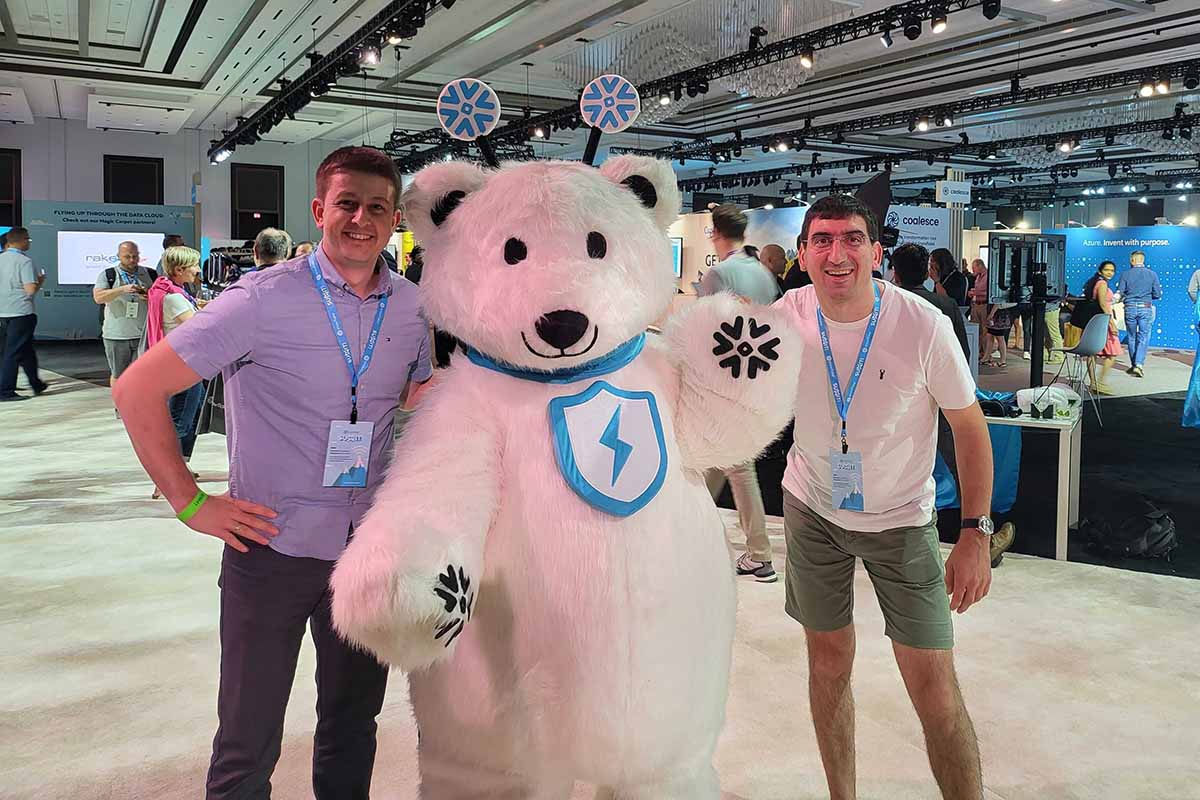
TL; DR: Our interest in going beyond what’s expected applies to every single aspect of our business. We’re not simply interested in being Snowflake experts. We’re looking to take our expertise to the highest level of a Snowflake partnership. From the certification of talented developers, participating in the Snowflake community, and working closely with our customers, here’s how we’re doing it.
As a Data Science Lead involved in different data and machine learning projects, I know from experience that working with various data warehouses and lakes, blending data from disparate sources, and visualizing data through a diverse set of BI tools and applications — all while sharing data securely — can be quite challenging.
Delivering robust analytics solutions usually requires all sorts of tools and libraries. However, in recent years, the introduction of Data as a Service (DaaS) and Data Warehouse as a Service (DWaaS), such as Snowflake, is helping professionals design and develop highly sophisticated data processing and analyses in ways customers thought impossible.
Our experienced team has worked with many clients who acknowledge the importance of the data cloud. And because more and more companies are expressing such an interest, solidifying our partnership with Snowflake has become a priority. This involves increasing the number of Blankfactor engineers obtaining the SnowPro Core/Advanced Certification.
To us, these certifications demonstrate we have a thorough understanding of the Snowflake ecosystem — and also show potential customers we have the necessary knowledge and experience to develop solutions that drive business objectives. Here’s how we’re doing just that by building up our Snowflake partnership.
The foundation of Snowflake expertise at Blankfactor
When I joined Blankfactor, I already had some experience using Snowflake, but mostly as an end user. Or, as a data user, I should say –- working on a universal semantic layer solution, blending data from various sources.
At Blankfactor, I was offered the unique opportunity of being a part of a team of Snowflake experts. This meant learning everything about Snowflake’s architecture, services, and unique features that make it such a popular data platform. Here, I’m able to further extend my knowledge and elevate my Snowflake expertise to a whole new level — both conceptually and in practice.
Why we’re becoming certified Snowflake partners
A few months ago, Blankfactor became a part of the Snowflake Partner Network. As a company, this partnership allows us to harness the full potential of the data cloud and leverage Snowflake’s flexibility, performance, and ease of use to deliver more meaningful data insights to our customers.
There are different levels to a Snowflake partnership — Select, Premium, and Elite. A partner’s designation is based on factors such as the number of certified employees, reference architectures, customer references, and of course, final approval by Snowflake. At the time of this writing, we have already covered the requirements for a Select partner. Our goal is to become Premium in August and Elite by September of this year.
I’m happy my SnowPro Core certification is a step towards achieving the next partnership level for Blankfactor. Yet, I also realize certifications are just a starting point in this journey.
The Snowflake Summit experience
For four days in June, a group of Blankfactor engineers from Bulgaria and Colombia, led by Data Practice Lead Nikolay Nyalgolov, gathered with thousands of Snowflake representatives, partners, and customers to share ideas and best practices. We got the latest news and updates directly from Snowflake’s executives and architects. We also had the chance to attend dozens of sessions, keynotes, and hands-on labs and gather valuable insight into one of the most popular data technologies in today’s market.
As a team, our objective for the summit was three-fold:
- First, we sought to get acquainted with representatives from other companies and exchange experiences around Snowflake. One of the best ways to continue learning is to actively participate in the community and exchange knowledge, doubts, tricks, and insights.
- We were also eager to present our company and our data practice to potential customers and technology partners. At the summit, we had the opportunity to personally meet a client with whom Blankfactor has worked for a few years now. Our remote collaboration has been more than successful so far, but nothing beats face-to-face.
- And last, but definitely not least, our participation in the Snowflake Summit was not only about networking and learning. We were also keen on passing the SnowPro Core Certification Exam onsite.
Glimpsing the latest Snowflake features first
It’s been three years since the last in-person Snowflake Summit took place in San Francisco in 2019. Obviously, due to the COVID-19 pandemic, such an onsite event was impossible for a long time, and Snowflake had to wait for the right moment to throw a landmark conference in Las Vegas like no other.
Since very few new major features and functionalities were announced as of 2019, the Snowflake Summit 2022 was the right time to share what’s cooking and what’s about to be officially released this year.
Some of the prominent features that Snowflake showed off at the Summit are also key data science enablers. These include:
- As a Python user, I was very excited when Snowflake announced that Python would join Java and Scala as a natively-supported language. In addition to the Python API and UDF support, Snowflake announced support for table functions, stored procedures, and vectorized UDFs.
- Combined with the previously announced Anaconda integration, which makes Snowflake quite a significant player in the data science space, Snowpark for Python enables machine learning modeling and training. It also allows the use of Snowsight worksheets, all while removing the burden of library dependencies and managing versions. The tools for rapid model building and deployment are there now.
- Streamlit is an open-source app framework for data science teams. It enables Python developers to transform scripts into good-looking web applications.
- The acquisition of Streamlit allows Snowflake to integrate this technology. It also opens the door for the data community to build visually appealing applications for both public and internal consumption.
- Hybrid tables enable a unistore that consists of analytical and transactional workloads on a single data platform. This is a major shift from the 40-year-old practice of independent data storage, creating OLAP and OLTP silos.
- With this announcement, Snowflake becomes an appropriate platform for OLTP workloads, as well — just a hint for anyone planning to pass the SnowPro Core Certification Exam after the private preview period is over.
Engineering impact with advanced data solutions
By leveraging a growing team of top professionals and extending our strategic partnership with Snowflake, Blankfactor is a key technology enabler for companies willing to take the next step in their digital transformation journey.
We’re here to fill in your blanks and move your business forward with advanced data solutions – fast. From cloud migrations to unlocking your data with enterprise AI, our Snowflake experts can unlock your data. Find out more about our Snowflake success stories, including data platform modernization and data solutions for an innovative RaaS product.
Ready to see engineering impact? Contact us today for your 60-minute solution session.
Was this article insightful? Then don’t forget to look at other blog posts and follow us on LinkedIn, Twitter, Facebook, and Instagram.









